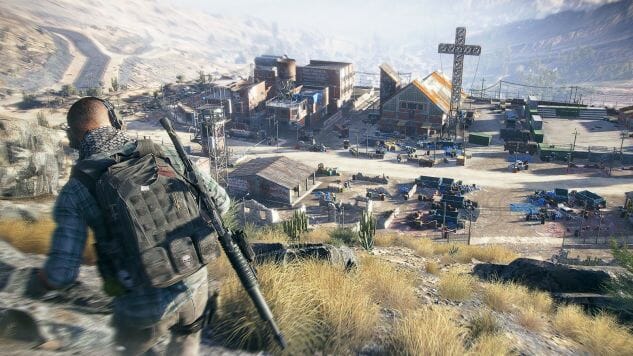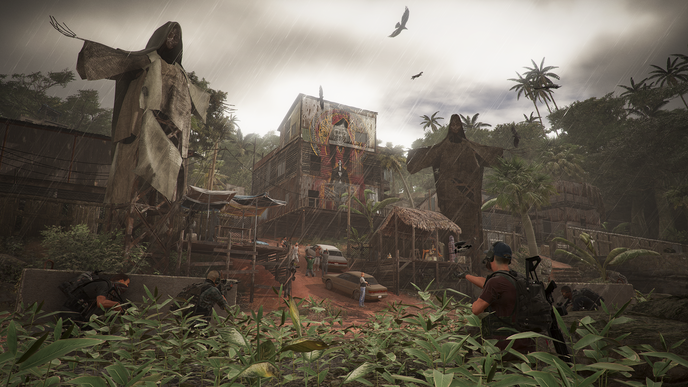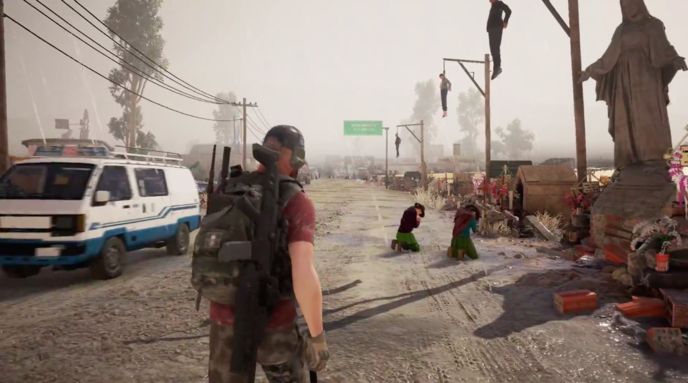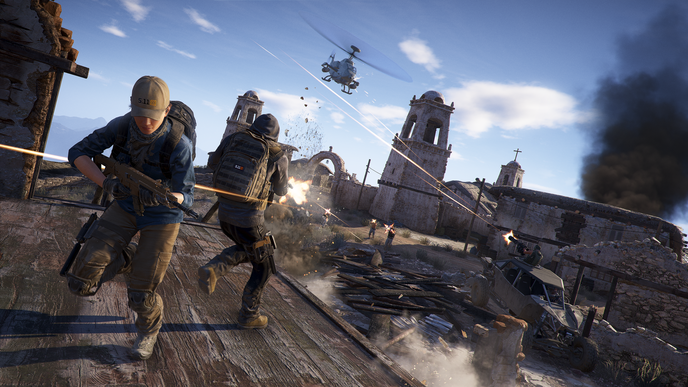Tom Clancy’s Inherent Silliness: Why Ghost Recon Wildlands Couldn’t Escape Its Fate

Ghost Recon Wildlands is a silly game. One might be tempted to think that it’s an intentionally silly game bordering on satire. I mean, after all, it’s almost a parody of games in its genre: it’s a third-person shooter game where four operatives, a handler, and some almost-Communist rebels take on and fully dismantle the infrastructure of a country that’s been fully taken over by a drug cartel.
Noah Caldwell-Gervais, a game critic who I respect but often disagree with, wrote in his pre-review for Polygon that this was “tonal flippancy.” For Caldwell-Gervais, the self-seriousness bled over to comedy, and as he tells it that very tonal shift made it easier for him to accept the game’s gung-ho Tom Clancy presentation of the world. Heather Alexandra, writing for Kotaku, claimed that the gameplay was “too chaotic” and that the implicit and explicit political statements were “too vapid” to even compete with a series like Splinter Cell. She ended her review with a blanket statement that Wildlands “succeeds at being nothing,” a damning statement if there has ever been one.
Here at Paste, Reid McCarter’s review resonated with myself and many other critics. One of McCarter’s central claims is thatWildlands’s presentation of the creation, governmentalization and distribution of drugs is not only bad (in a political sense) but also actively reproducing the same narratives about drugs that fuel the current international War on Drugs.
Before review codes for the game went out, I had the opportunity to speak with two developers for Ghost Recon Wildlands: Sam Strachman is the game’s Narrative Director and Dominic Butler is the Lead Game Designer for the project. They were gracious, smart and seemed genuinely interested in telling me about the game that they’ve spent five years developing. Both stressed that Wildlands was above and beyond the scope and scale of any game of its kind.
Butler’s pitch was simple and clean, stressing the game’s “massive, dangerous and responsive open world” that was “diverse both in the types of terrain and the kind of people [you] meet as you go across it.” Wildlands is, after all, based on the real country of Bolivia, and the developers pushed on realism, or at least mimicry, across the board. The environment looks like the real environment of the country. There are many kinds of people in many kinds of social positions because that’s how it really is. Strachman ran down a long list of research and contextual information. As he said,
The first year of development, for the narration team, on taking a trip to Bolivia, we talked the people there, we talked to officials, we talked to politicians, we talked to experts around the world in cartels, in anti-drug enforcement and counter-narcotics, we talked to special operations guys. We got to talk to some real special operations guys who had been down in Bolivia, and we talked to them about how it works and how these things work. We watched every documentary we could, we read every book we could. We talked to journalists, we talked to documentarians, we talked to novelists. Basically anyone we felt had contributed to this topic, we did our best to talk to and see things from their perspective.
This massive load of research might remind you of any number of other blockbuster game franchises that attempt to ground themselves in the real world. Ubisoft’s own Assassin’s Creed series might be the grandest pillar of this kind of design, spending interminable research time and money figuring out exactly what a place like Florence, Italy looked like in a very particular time.
All of this is based on the simple premise that the more a game world is grounded in our reality the more “immersive” it becomes. Immersion seems to operate in these kinds of games as a foundation upon which anything can be built; if you make a world that feels real enough, then you can stack any kind of shooting, jumping, driving or flying on top of it. After all, if the bottom layer holds and the player still feels like they’re in a living, breathing world, then that will keep them anchored if, say, being a super soldier might take them out of it.
When I’m driving down the road in a border province that’s heavily contested between rebels and cartels, I might feel “immersed.” If that road is occasionally dotted with the crucified bodies of rebels with warning signs hanging around their necks, I can buy that this is a bad place with two factions that will do anything and everything to destroy their enemies. In a film like Sicario, which has a very similar scene, it sells a sense of danger and depravity around cartels and how they do business. It is, in that film’s terms, a place for wolves. But in Wildlands I saw this scene and pulled over to the side of the road. I wanted to get a closer look. There, on the ground beneath the crucified men amongst the citizens looking up at them, was a fuel collectable. It flashed a shiny white. I picked it up. It added more fuel resources to my inventory. I got back in my car and drove away.
That incongruity between the “immersive,” well-researched, conceptual layer and the “fun” layer of game mechanics that are honed to keep me and my friends coming back for more is, I think, what the negative reviews of the game have hinged on. Wildlands is a game that wants to be more than the sum of its parts, but it can’t quite figure out how to slam the peanut butter of tactical Tom Clancy into the funtime chocolate of Grand Theft Auto V-ish cooperative mayhem.
It’s not the fault of the people who are building the world. It might not be anyone’s “fault” at all, at least in the sense that thousands of broad and specific decisions brought the development team to this place. In the end, the incongruity between “immersion” and gameplay in Wildlands is Tom Clancy’s fault.
I don’t mean the human meat that made up the historical figure of Tom Clancy. I mean the arrangement of ideas that make up “Tom Clancy” as a broad brand of novels, films and videogames that all embrace some very implicit and explicit ideas. Tom Clancy is a set of concepts that are applied to particular media, and the Wildlands developers dealt with that explicitly. Sam Strachman said this:
“When we first started, the first question we asked ourself was ‘What does it mean to be a Clancy game? What does it mean to be in the Clancy universe? What do all the Clancy books, all the movies, all the games have in common?’ What it came down to, for us, was this question of ‘What if?’ Every Clancy novel is asking this question: ‘What if, in the near future, this thing happened?’ And for us that question was ‘What if a drug cartel moved in Bolivia, took over a huge part of the country, and turned it into a narcostate?’”
From this perspective, the position of being a developer on a Tom Clancy game is like being trapped between a rock and a hard place. To create a Tom Clancy game, you have to speculate about the future, but it must always be a future in crisis. The Clancyverse is made up of threats to American domestic security and foreign power projection. There is no way of conceiving of a story set within this political framework that isn’t based on fears about the security of some kind of American institution or ideal, and reading Tom Clancy novel plot summaries one after the other makes this readily apparent.
Wildlands is a speculative game, but it’s speculative within a framework that only sees the world as threatened and precarious. Tom Clancy worlds are always teetering on the brink of total collapse at the hands of powerful, anti-American forces. There is a thin line between those who would do America and its allies harm, and that line is held by powerful men and women who are ready to die for their country. It is, to use a word from the opening of this piece, silly.
People fighting and dying for their country isn’t silly, and neither is the fact that the United States uses covert operations all over the world to manipulate regions and political frameworks that I can’t pretend to understand. Those are all serious things. What is silly is that making a Tom Clancy game in our current game development environment means pleasing a number of different vocal communities that all want vastly different things. The developers need to hit this high bar of paranoia to fulfill the Tom Clancy fantasy of political edginess, but they also have to pack the world with collectables. There has to be a serious story, but there also needs to be room for me and a crew of three friends to mess around in a vast open world. There need to be men hanging, but I need to be able to supply up at their feet.
When you travel to an “immersive” Tom Clancy world, you’re entering a construct of complete political paranoia that is masking itself as completely real. If Tom Clancy products are merely one “what if?” away from our real world, then we have to begin asking if all versions of “what if?” are equal. And if they aren’t, what’s the responsibility that game developers have to the people they are asking their “what if?” questions about?
We are living under a government that wants to ban immigration because of perceived security threats. The President of the United States literally wants to build a wall between our country and Mexico in order to prevent an ambiguous assortment of drugs, violence and other social ills from moving over the border. Ethno-nationalism has been embraced by elected members of our legislative branch. All of these ideas and policies require a target. All of them ask a deeply speculative “what if?” question, a “what if?” that presupposes that every other actor in the world is either a threat or an ally to American power. As a former President said, “you’re either with us, or against us.”
Wildlands embraces the same speculative imagination that fuels all of these contemporary political ideas. It is a game that immerses the player within a fully-realized world in which the worst political fears have come true. A consolidated power exists, it threatens America, and only extreme violence and unchecked power can swing back against it.
The reviews of Wildlands have pointed out how inconsistencies have rendered the game strange, or silly, or a mixed bag of bad elements. It’s that silliness that comes through, but on the other end of really thinking about the game, it almost borders on absurdity. It’s not that there aren’t elements of real cartels and real politics in the game; there are drug submarines and people are hanged from posts as a warning. The silliness of the game is that Wildlands is a greatest hits of cartels. It is an omnibus, generalized model that seems jam packed with existential threats. In the face of that challenge, America has to become powerful. To truly address them, the country has to become great again. It’s so silly that it’s laughable, but it’s also a tragedy.
Cameron Kunzelman tweets at @ckunzelman and writes about games at thiscageisworms.com. His latest game, Epanalepsis, was released last year. It’s available on Steam.


